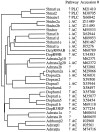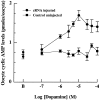Cloning and functional characterization of a novel dopamine receptor from Drosophila melanogaster
- PMID: 8656286
- PMCID: PMC6578617
- DOI: 10.1523/JNEUROSCI.16-12-03925.1996
Cloning and functional characterization of a novel dopamine receptor from Drosophila melanogaster
Abstract
A cDNA clone is described that encodes a novel G-protein-coupled dopamine receptor (DopR99B) expressed in Drosophila heads. The DopR99B receptor maps to 99B3-5, close to the position of the octopamine/tyramine receptor gene at 99A10-B1, suggesting that the two may be related through a gene duplication. Agonist stimulation of DopR99B receptors expressed in Xenopus oocytes increased intracellular Ca2+ levels monitored as changes in an endogenous inward Ca2+-dependent chloride current. In addition to initiating this intracellular Ca2+ signal, stimulation of DopR99B increased cAMP levels. The rank order of potency of agonists in stimulating the chloride current is: dopamine > norepinephrine > epinephrine > tyramine. Octopamine and 5-hydroxytryptamine are not active (< 100 microM). This pharmacological profile plus the second-messenger coupling pattern suggest that the DopR99B receptor is a D1-like dopamine receptor. However, the hydrophobic core region of the DopR99B receptor shows almost equal amino acid sequence identity (40-48%) with vertebrate serotonergic, alpha 1- and beta-adrenergic, and D1-like and D2-like dopaminergic receptors. Thus, this Drosophila receptor defines a novel structural class of dopamine receptors. Because DopR99B is the second dopamine receptor cloned from Drosophila, this work establishes dopamine receptor diversity in a system amenable to genetic dissection.
Figures






Similar articles
-
Agonist-specific coupling of a cloned Drosophila melanogaster D1-like dopamine receptor to multiple second messenger pathways by synthetic agonists.J Neurosci. 1997 Sep 1;17(17):6545-53. doi: 10.1523/JNEUROSCI.17-17-06545.1997. J Neurosci. 1997. PMID: 9254667 Free PMC article.
-
A primordial dopamine D1-like adenylyl cyclase-linked receptor from Drosophila melanogaster displaying poor affinity for benzazepines.FEBS Lett. 1995 Apr 3;362(2):131-8. doi: 10.1016/0014-5793(95)00224-w. FEBS Lett. 1995. PMID: 7720859
-
A Drosophila dopamine 2-like receptor: Molecular characterization and identification of multiple alternatively spliced variants.Proc Natl Acad Sci U S A. 2002 Oct 29;99(22):14554-9. doi: 10.1073/pnas.202498299. Epub 2002 Oct 21. Proc Natl Acad Sci U S A. 2002. PMID: 12391323 Free PMC article.
-
Molecular neurobiology of dopaminergic receptors.Int Rev Neurobiol. 1993;35:391-415. doi: 10.1016/s0074-7742(08)60573-5. Int Rev Neurobiol. 1993. PMID: 8463063 Review.
-
Insect octopamine receptors: a new classification scheme based on studies of cloned Drosophila G-protein coupled receptors.Invert Neurosci. 2005 Nov;5(3-4):111-8. doi: 10.1007/s10158-005-0001-z. Epub 2005 Oct 24. Invert Neurosci. 2005. PMID: 16211376 Review.
Cited by
-
L-DOPA-Induced Dyskinesia in a Genetic Drosophila Model of Parkinson's Disease.Exp Neurobiol. 2020 Aug 31;29(4):273-284. doi: 10.5607/en20028. Exp Neurobiol. 2020. PMID: 32921640 Free PMC article.
-
Dopamine receptor antagonists as new mode-of-action insecticide leads for control of Aedes and Culex mosquito vectors.PLoS Negl Trop Dis. 2015 Mar 20;9(3):e0003515. doi: 10.1371/journal.pntd.0003515. eCollection 2015 Mar. PLoS Negl Trop Dis. 2015. PMID: 25793586 Free PMC article.
-
Arthropod D2 receptors positively couple with cAMP through the Gi/o protein family.Comp Biochem Physiol B Biochem Mol Biol. 2007 Jan;146(1):9-19. doi: 10.1016/j.cbpb.2006.08.018. Epub 2006 Oct 10. Comp Biochem Physiol B Biochem Mol Biol. 2007. PMID: 17134931 Free PMC article.
-
Circadian modulation of dopamine receptor responsiveness in Drosophila melanogaster.Proc Natl Acad Sci U S A. 2000 Feb 15;97(4):1873-8. doi: 10.1073/pnas.97.4.1873. Proc Natl Acad Sci U S A. 2000. PMID: 10677549 Free PMC article.
-
Amphioxus expresses both vertebrate-type and invertebrate-type dopamine D(1) receptors.Invert Neurosci. 2010 Dec;10(2):93-105. doi: 10.1007/s10158-010-0111-0. Epub 2010 Nov 27. Invert Neurosci. 2010. PMID: 21113730
References
-
- Ali DW, Orchard I. Characterization of dopamine and serotonin receptors on the salivary glands of the locust, Locusta migratoria . Biog Amines. 1994;10:195–212.
-
- Arakawa S, Gocayne JD, McCombie WR, Urquhart DA, Hall LM, Fraser CM, Venter JC. Cloning, localization, and permanent expression of a Drosophila octopamine receptor. Neuron. 1990;4:343–354. - PubMed
-
- Barnard EA, Miledi R, Sumikawa K. Translation of exogenous messenger RNA coding for nicotinic acetylcholine receptors produces functional receptors in Xenopus oocytes. Proc R Soc Lond [Biol] 1982;215:241–246. - PubMed
-
- Bodnaryk RP. Identification of specific dopamine- and octopamine-sensitive adenylate cyclases in the brain of Mamestra configurata Wlk. Insect Biochem. 1979;9:155–162. - PubMed
-
- Brown CS, Nestler C. Catecholamines and indolalkylamines. In: Kerkut GA, Gilbert LI, editors. Comprehensive insect physiology, biochemistry and pharmacology, Vol. 11. Pergamon; Oxford: 1985. pp. 436–497.
Publication types
MeSH terms
Substances
Associated data
- Actions
Grants and funding
LinkOut - more resources
Full Text Sources
Other Literature Sources
Molecular Biology Databases
Miscellaneous
